- Home
- Garden wildlife
- Mammals
- Rodents
Brown rat Rattus norvegicus
Introduced as stowaways from Russia in the eighteenth century, brown rats have replaced the once abundant black rats (which came to Britain with the Romans), and which are now very rare. They are the wild cousins of the fancy rats kept as pets, Brown rats get a terrible but largely unfair press. They are intelligent, adaptable animals, and while they can carry some human diseases, the risk to most people is very small. As long as an area isn’t overrun by them, they can be engaging neighbours.
In small, well-fed groups, rats groom meticulously but as colonies become more crowded, they groom less and scuffles between individuals are more common. They have keen senses of hearing and smell and use scent and short, ultrasonic calls to communicate. They may also use ultrasound to echolocate in a similar way to bats.
Rats tend to move about along well-trodden routes and, with practice, it is possible to spot these ‘runs’. They are excellent swimmers (both on the surface and underwater) and can climb, readily getting into the upper storeys of buildings. They dig extensive burrows, often in sloping ground or the sides of ditches, or beneath flat stones or tree roots, and burrows may be used for several generations.
In urban areas, rats will make use of buildings, nesting in floor cavities or beneath floorboards. The English House Condition Survey in 2007 found that rats were present in three per cent of gardens but in only four in a thousand domestic properties.
Appearance and activity Brown rats are much larger than either mice or voles, with a body length up to 28cm and a tail nearly as long. They have grey-brown fur and a long, scaly tail, which is used to balance. In water, they can be distinguished from water voles by their more pointed face, prominent ears and longer tail. Young rats resemble adult mice, but have much broader hindfeet and relatively thicker tails.
Rats are active throughout the year and mostly nocturnal but will take advantage of opportunities to feed during daylight.
Status, population size and distribution Non-native and common; GB population 7,000,000; about 1,000,000 live in or close to urban buildings. Dave Cowan, an author of the English House Condition Survey, estimated that, taking into account rats living in and around homes, commercial properties and in sewers, inhabitants of UK cities are probably within 50m of a rat – quite a bit further than the often quoted figure of ‘six feet’.
Reference:
Baker, P.J., Ansell, M.J., Dodds, P.A.A., Webber, C.E., Harris, S. (2003) Factors affecting the distribution of small mammals in an urban area. Mammal Review 33 (1): 95-100 Abstract
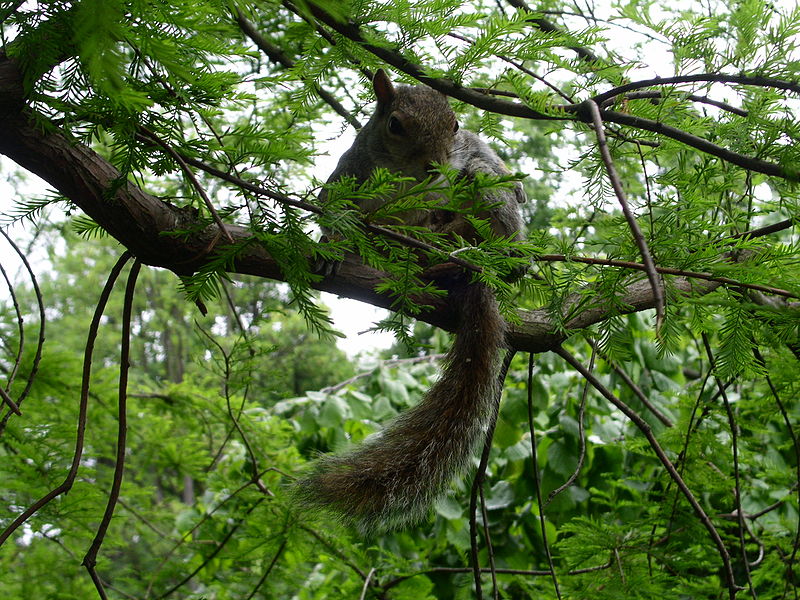
Grey squirrel in Buckingham Palace garden
They nest in dens made in tree hollows or in nests (or ‘dreys’), swapping between nest sites every few days and will often share nests with unrelated individuals. Dens are difficult to identify but dreys are more conspicuous. They are about 30cm in diameter and often built amongst climbing plants such as ivy or honeysuckle, usually in more sheltered sites than those of birds’ nests, in clefts or close to the trunk (birds are more likely to nest in the crown of the tree) and tend to be high up (above 5m). Urban grey squirrels will use other nest sites as well, including bird boxes, in roofing thatch and under tiles, and have been known to nest in cavity walls.
Diet Grey squirrel are agile climbers but will spend a lot of time on the ground foraging. Their diet includes acorns, beech mast, fruit, fungi and tree bark, and they will also eat insects and occasionally birds’ eggs. During late summer and autumn, food is hoarded in small caches – several hazelnuts or beech masts, for example, buried just beneath the soil surface – sometimes in the middle of a lawn or in borders, which have the added value of ‘caches’ of spring bulbs supplied by gardeners.
Appearance and activity 24-28cm body length with a tail almost as long. Predominantly grey, with a brown tinge along their backs; in summer, their flanks and legs can be a lot browner, and black and albino grey squirrels are common in some parts of England. Grey squirrels are larger than their red counterparts (weighing almost twice as much) and lack the winter ear tufts sported by red squirrels.
Grey squirrels divide opinion: some people see them as a nuisance, stripping bark from trees, making a noise in roof spaces or pilfering bulbs, but to many others, their acrobatics on bird-feeders or their bold advances have an undeniable appeal. They are adept problem-solvers and learn from watching their peers, particularly when it comes to finding food. For most British urbanites, grey squirrels are the only "wild" mammals they get to see.
Squirrels do not hibernate and are active throughout the year. In summer, they are most active several hours after sunrise and before sunset, but during bad weather, they may remain in their nest for one or two days.
Status, population size and distribution Non-native and common; GB population 2,600,000 (England, 2,000,000). They are widely distributed in England and Wales and their range is expanding in Scotland and Northern Ireland.
Red squirrel Sciurus vulgaris
Red squirrel are native to Europe, but since the introduction of grey, they have been displaced from much of England and Wales, in large part because grey squirrel are better able to compete for resources in some habitats – in particular, deciduous woodland. Red squirrels are much smaller than greys, weighing in at 300g compared with 600g for greys. Until the 1940s, red squirrel were still comparatively common, but in recent years the disease squirrelpox has hastened the fall in their numbers. Squirrelpox is fatal to reds, but is carried and spread by greys.
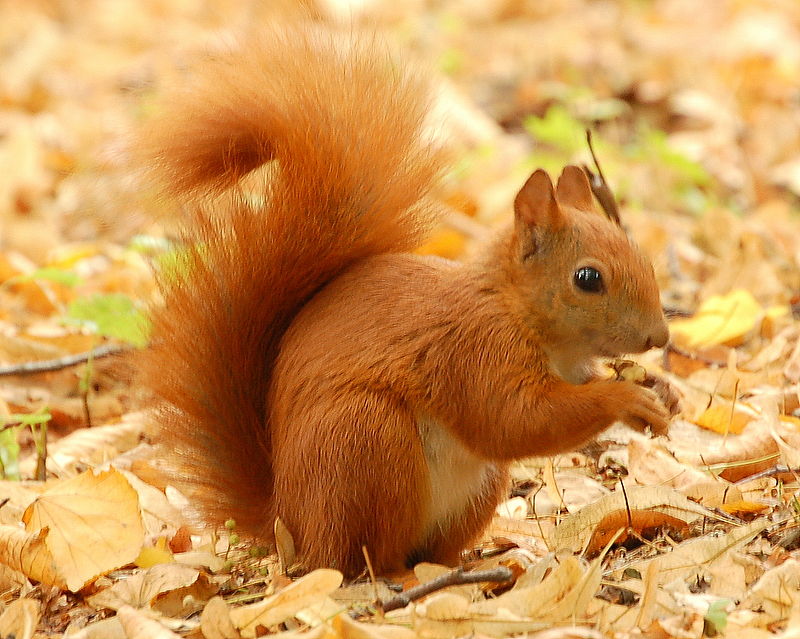
Appearance and activity only 18-24cm body length. Red squirrel are more arboreal than grey, rarely coming to the ground, and can be encouraged to visit bird tables or feeding stations in the garden by providing an aerial route along a thick rope.
Diet Their food is made up of seeds, pinecones, tree shoots, flowers, berries, tree bark and lichens, but they lack the ability to digest acorns, which gives grey squirrel a competitive advantage.
Status , population size and distribution. Red squirrels are native, but fewer than 160,000 are present in England, Scotland and Wales today, most (three-quarters) in Scotland. Where reds do still occur – in areas of Wales and northern England, and in much of Scotland and Ireland – they readily make use of gardens and urban green spaces in towns and cities, just as much so as their transatlantic cousins.
Mice
Two species of mouse are common in urban environments: wood mice and house mice, but it is the former that is most likely to be encountered in the garden and in out-buildings.
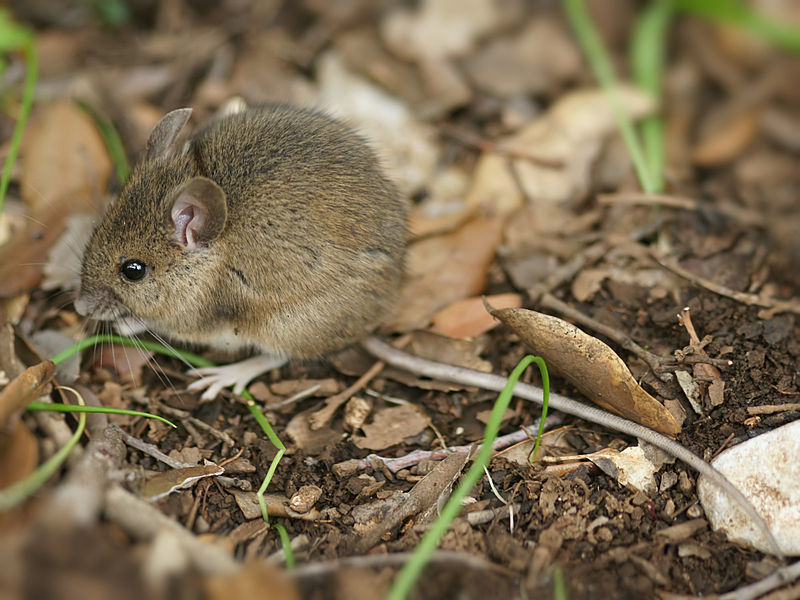
Wood mouse Apodemus sylvaticus
Wood mice are native species characteristic of woodland, living in the leaf litter, but are found in habitats as diverse as farmland, sand dunes, hedgerows and road verges, and are common in green urban spaces such as gardens. They are adaptable and opportunistic, readily taking advantage of food on bird tables and coming into houses during cold weather.
Appearance and activity 8-11cm body length, with the same length of tail. Wood mice are recognisable by their large ears and prominent eyes. They are dark brown with a pale grey underside and a small patch of yellowish fur between their front legs. Their tails are long and dark, with only sparse hair. They are mainly nocturnal but occasionally active above ground during the day in summer.
Diet Their food mainly consists of seeds (such as acorn and sycamore), but includes buds (especially blackberry), fruits, nuts, snails, insects, fungi, moss and tree bark.
Status, population size and distribution Native, widespread and common. GB population 38,000,000. The population trend is unknown. Wood mice are present throughout Great Britain and Ireland, including on most of the large islands and many of the small ones.
In some areas, wood mice might be confused with yellow-necked mice Apodemus flavicollis, which are found in south and southeast England and central Wales. They are slightly larger than wood mice, and have proportionally longer tails. These mice are uncommon and mainly found in woods and hedgerows. The occasionally shelter in outbuildings in winter.
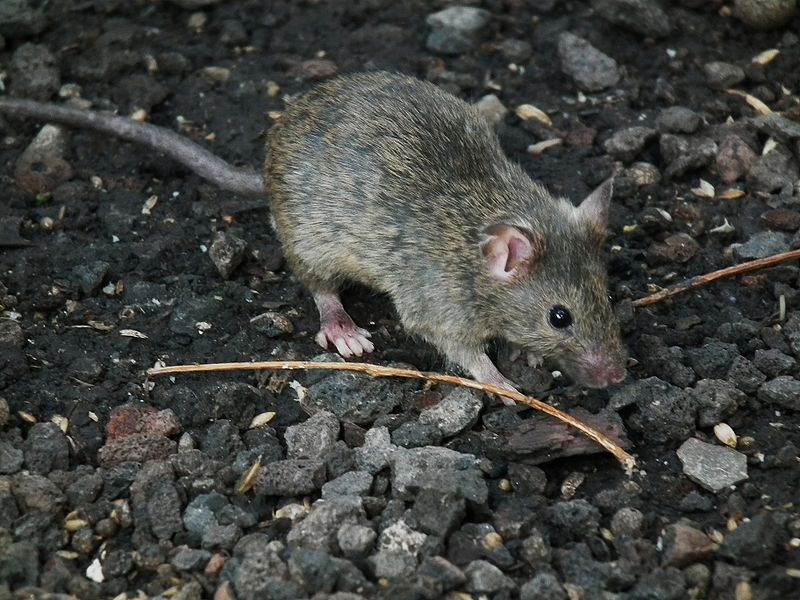
House mouse Mus musculus
House mice seem to have arrived in the Iron Age, and are ubiquitous in the British Isles.
Appearance and activity House mice are smaller than wood mice (body 6-10cm) and have long hairless tails. They are grey-brown in colour, with large pink ears and a narrow face. They can burrow efficiently, but are much more frequently found inside houses, in floor and wall spaces, gnawing through wood and plastic to reach new areas. They are abundant in farm buildings where food is available.
Diet Mainly seeds and fruits, but they also eat invertebrates and almost anything edible. Including cheese.
Status, population size and distribution There are about 5.4 million house mice in Great Britain, and the population seems to be stable. They are found everywhere in the British Isles, including most small islands.
Voles
Three species of vole – bank, field and water vole – are widespread in Britain, while two subspecies of the common vole are separately found on the islands of Guernsey and Orkney. The common vole was native to mainland Britain in the last interglacial, but failed to recolonise when the ice melted. Voles are larger, have smaller ears and much shorter tails than mice.
Bank and field voles are the most likely to be found in urban areas but water voles have been recorded on rivers and canals in more than thirty towns and cities. Unfortunately they are in steep decline, so if your riverside garden contains them please let your local Wildlife Trust know.
Voles rely more on thick ground cover than does the wood mouse and tend to be less common in residential gardens, unless they are particularly overgrown. In one study of households in Bristol1, wood mice were found at four-fifths (17 of 21) gardens, compared to only a single record of bank vole. In the same study, however, bank vole was present at seven out of eight non-garden sites (allotments, cemeteries, scrub and woodland) and field vole, at five of the sites.
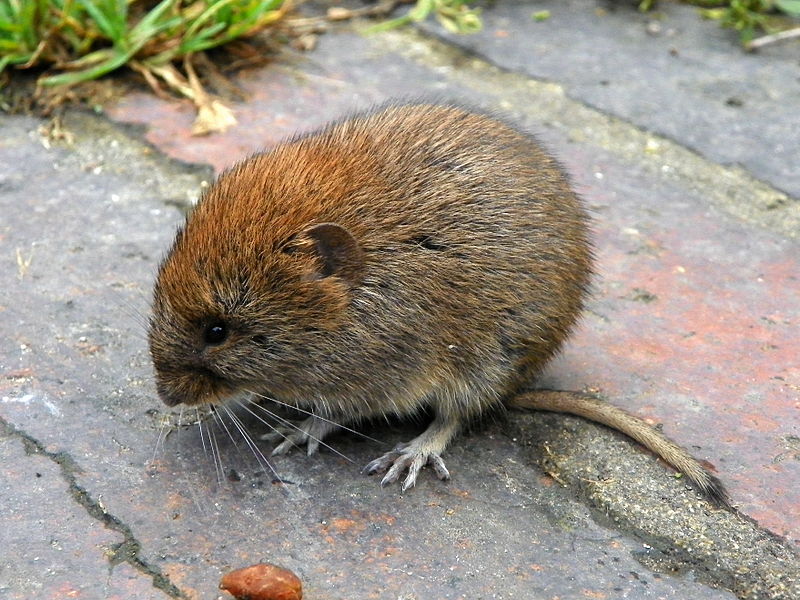
Bank vole Myodes glareolus
Bank voles make their nests in shallow burrows several centimetres below the ground surface, which they line with leaves, grasses or moss. Although they move around on the ground for the most part, they are agile climbers and use arboreal runways to reach haws and other fruit in hedges and bushes.
Appearance and activity Bank voles have a reddish-chestnut coat with a dirty white underside (field voles are similar in size and appearance, but only bank voles are ever a deep chestnut colour). They have small eyes and ears, and a blunt nose. At first sight, they might be confused with wood mice, but the latter have a longer tail and bound rather than scurry. They are active during both the day and night, particularly at dawn and dusk during the summer.
Diet Green leaves make up to half of their diet but fruits and seeds, and small amounts of fungi, roots, flowers and invertebrates are also eaten.
Status, population size and distribution Native (to GB), common and widespread; populations in Ireland were possibly introduced in the 1920s from Germany. GB population 23,000,000. The population trend is unknown. Bank voles are widely distributed throughout Britain and the south west of Ireland.
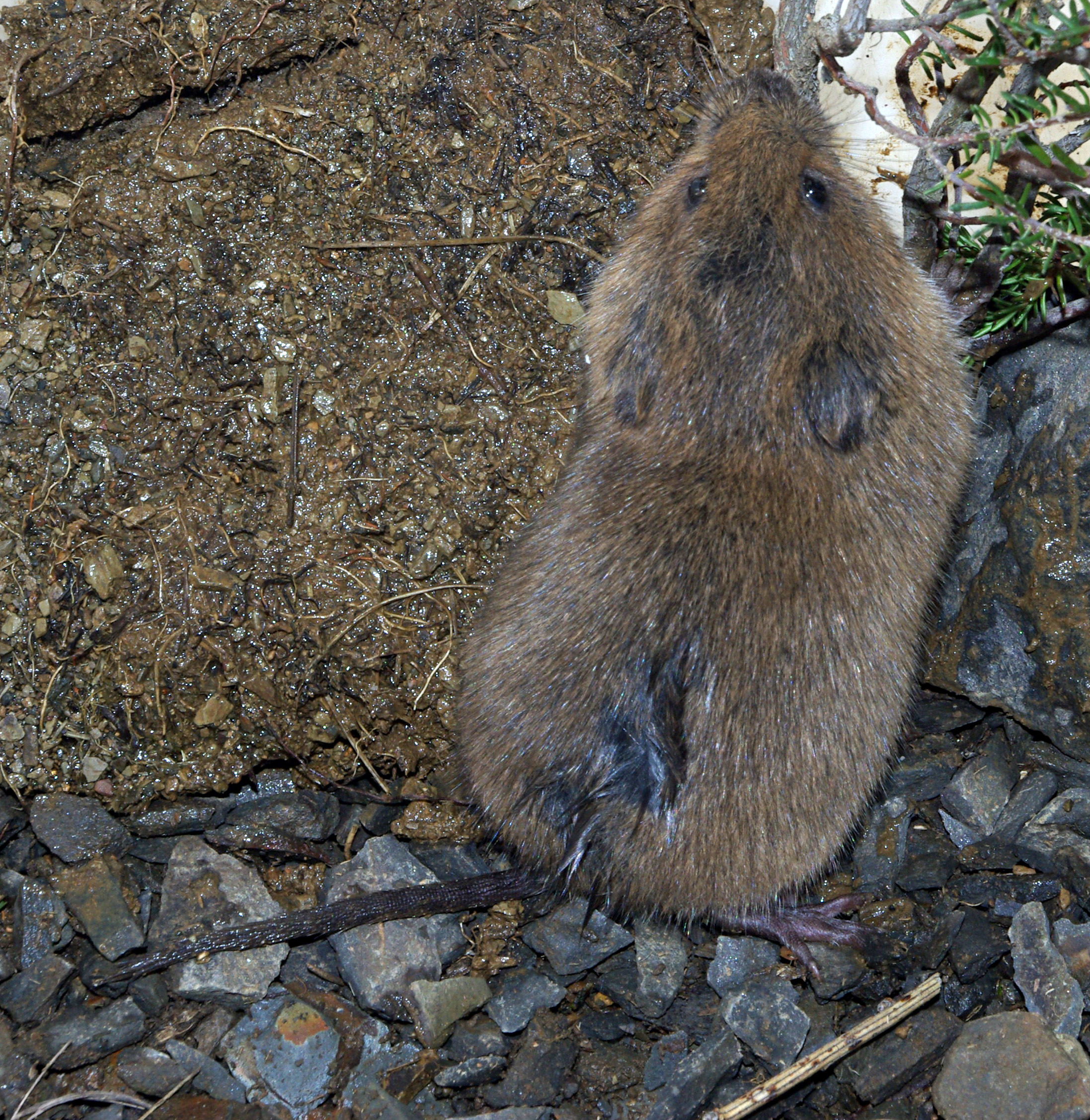
Field vole Microtus agrestis
Field voles are much less likely to be found in gardens except in those close to grassy fields and open woodland. They are very similar to bank voles in size, but have longer dark brown fur, shorter tails and smaller ears. Their habits and diet are similar to the bank vole.
Status, population size and distribution Native, locally common, poulation about 75 million. They are a very important prey species for most British predators. They are found throughout mainland Britain, but not in Ireland or the offlying islands.
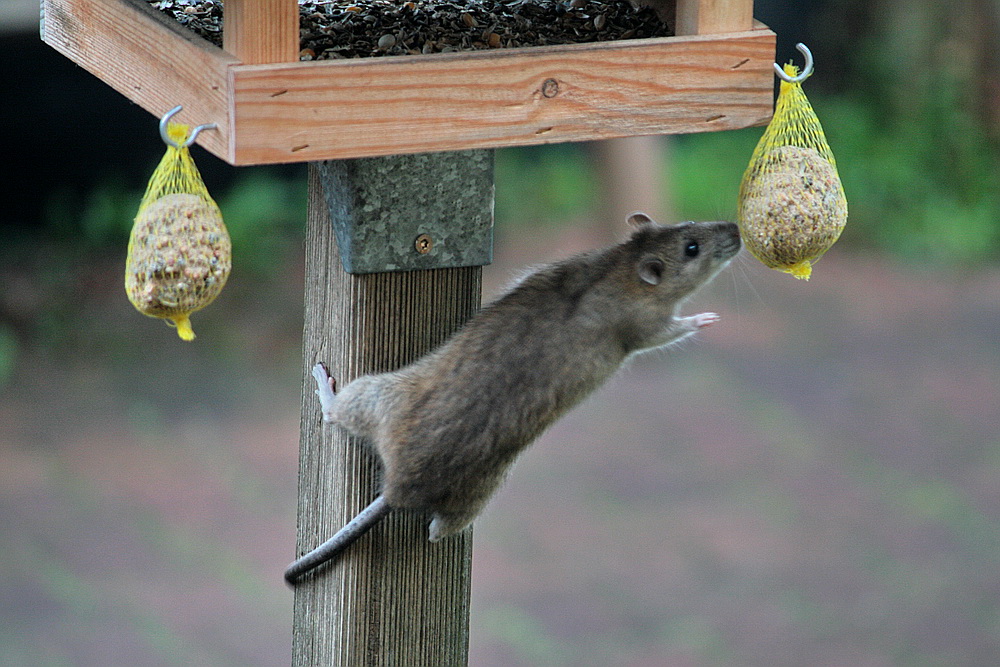

Grey squirrel in Buckingham Palace garden
They nest in dens made in tree hollows or in nests (or ‘dreys’), swapping between nest sites every few days and will often share nests with unrelated individuals. Dens are difficult to identify but dreys are more conspicuous. They are about 30cm in diameter and often built amongst climbing plants such as ivy or honeysuckle, usually in more sheltered sites than those of birds’ nests, in clefts or close to the trunk (birds are more likely to nest in the crown of the tree) and tend to be high up (above 5m). Urban grey squirrels will use other nest sites as well, including bird boxes, in roofing thatch and under tiles, and have been known to nest in cavity walls.
Diet Grey squirrel are agile climbers but will spend a lot of time on the ground foraging. Their diet includes acorns, beech mast, fruit, fungi and tree bark, and they will also eat insects and occasionally birds’ eggs. During late summer and autumn, food is hoarded in small caches – several hazelnuts or beech masts, for example, buried just beneath the soil surface – sometimes in the middle of a lawn or in borders, which have the added value of ‘caches’ of spring bulbs supplied by gardeners.
Appearance and activity 24-28cm body length with a tail almost as long. Predominantly grey, with a brown tinge along their backs; in summer, their flanks and legs can be a lot browner, and black and albino grey squirrels are common in some parts of England. Grey squirrels are larger than their red counterparts (weighing almost twice as much) and lack the winter ear tufts sported by red squirrels.
Grey squirrels divide opinion: some people see them as a nuisance, stripping bark from trees, making a noise in roof spaces or pilfering bulbs, but to many others, their acrobatics on bird-feeders or their bold advances have an undeniable appeal. They are adept problem-solvers and learn from watching their peers, particularly when it comes to finding food. For most British urbanites, grey squirrels are the only "wild" mammals they get to see.
Squirrels do not hibernate and are active throughout the year. In summer, they are most active several hours after sunrise and before sunset, but during bad weather, they may remain in their nest for one or two days.
Status, population size and distribution Non-native and common; GB population 2,600,000 (England, 2,000,000). They are widely distributed in England and Wales and their range is expanding in Scotland and Northern Ireland.
Red squirrel Sciurus vulgaris
Red squirrel are native to Europe, but since the introduction of grey, they have been displaced from much of England and Wales, in large part because grey squirrel are better able to compete for resources in some habitats – in particular, deciduous woodland. Red squirrels are much smaller than greys, weighing in at 300g compared with 600g for greys. Until the 1940s, red squirrel were still comparatively common, but in recent years the disease squirrelpox has hastened the fall in their numbers. Squirrelpox is fatal to reds, but is carried and spread by greys.

Appearance and activity only 18-24cm body length. Red squirrel are more arboreal than grey, rarely coming to the ground, and can be encouraged to visit bird tables or feeding stations in the garden by providing an aerial route along a thick rope.
Diet Their food is made up of seeds, pinecones, tree shoots, flowers, berries, tree bark and lichens, but they lack the ability to digest acorns, which gives grey squirrel a competitive advantage.
Status , population size and distribution. Red squirrels are native, but fewer than 160,000 are present in England, Scotland and Wales today, most (three-quarters) in Scotland. Where reds do still occur – in areas of Wales and northern England, and in much of Scotland and Ireland – they readily make use of gardens and urban green spaces in towns and cities, just as much so as their transatlantic cousins.
Mice
Two species of mouse are common in urban environments: wood mice and house mice, but it is the former that is most likely to be encountered in the garden and in out-buildings.

Wood mouse Apodemus sylvaticus
Wood mice are native species characteristic of woodland, living in the leaf litter, but are found in habitats as diverse as farmland, sand dunes, hedgerows and road verges, and are common in green urban spaces such as gardens. They are adaptable and opportunistic, readily taking advantage of food on bird tables and coming into houses during cold weather.
Appearance and activity 8-11cm body length, with the same length of tail. Wood mice are recognisable by their large ears and prominent eyes. They are dark brown with a pale grey underside and a small patch of yellowish fur between their front legs. Their tails are long and dark, with only sparse hair. They are mainly nocturnal but occasionally active above ground during the day in summer.
Diet Their food mainly consists of seeds (such as acorn and sycamore), but includes buds (especially blackberry), fruits, nuts, snails, insects, fungi, moss and tree bark.
Status, population size and distribution Native, widespread and common. GB population 38,000,000. The population trend is unknown. Wood mice are present throughout Great Britain and Ireland, including on most of the large islands and many of the small ones.
In some areas, wood mice might be confused with yellow-necked mice Apodemus flavicollis, which are found in south and southeast England and central Wales. They are slightly larger than wood mice, and have proportionally longer tails. These mice are uncommon and mainly found in woods and hedgerows. They occasionally shelter in outbuildings in winter.

House mouse Mus musculus
House mice seem to have arrived in the Iron Age, and are ubiquitous in the British Isles.
Appearance and activity House mice are smaller than wood mice (body 6-10cm) and have long hairless tails. They are grey-brown in colour, with large pink ears and a narrow face. They can burrow efficiently, but are much more frequently found inside houses, in floor and wall spaces, gnawing through wood and plastic to reach new areas. They are abundant in farm buildings where food is available.
Diet Mainly seeds and fruits, but they also eat invertebrates and almost anything edible. Including cheese.
Status, population size and distribution There are about 5.4 million house mice in Great Britain, and the population seems to be stable. They are found everywhere in the British Isles, including most small islands.
Voles
Three species of vole – bank, field and water vole – are widespread in Britain, while two subspecies of the common vole are separately found on the islands of Guernsey and Orkney. The common vole was native to mainland Britain in the last interglacial, but failed to recolonise when the ice melted. Voles are larger, have smaller ears and much shorter tails than mice.
Bank and field voles are the most likely to be found in urban areas but water voles have been recorded on rivers and canals in more than thirty towns and cities. Unfortunately they are in steep decline, so if your riverside garden containes them please let your local Wildlife Trust know.
Voles rely more on thick ground cover than does the wood mouse and tend to be less common in residential gardens, unless they are particularly overgrown. In one study of households in Bristol1, wood mice were found at four-fifths (17 of 21) gardens, compared to only a single record of bank vole. In the same study, however, bank vole was present at seven out of eight non-garden sites (allotments, cemeteries, scrub and woodland) and field vole, at five of the sites.

Bank vole Myodes glareolus
Bank voles make their nests in shallow burrows several centimetres below the ground surface, which they line with leaves, grasses or moss. Although they move around on the ground for the most part, they are agile climbers and use arboreal runways to reach haws and other fruit in hedges and bushes.
Appearance and activity Bank voles have a reddish-chestnut coat with a dirty white underside (field voles are similar in size and appearance, but only bank voles are ever a deep chestnut colour). They have small eyes and ears, and a blunt nose. At first sight, they might be confused with wood mice, but the latter have a longer tail and bound rather than scurry. They are active during both the day and night, particularly at dawn and dusk during the summer.
Diet Green leaves make up to half of their diet but fruits and seeds, and small amounts of fungi, roots, flowers and invertebrates are also eaten.
Status, population size and distribution Native (to GB), common and widespread; populations in Ireland were possibly introduced in the 1920s from Germany. GB population 23,000,000. The population trend is unknown. Bank voles are widely distributed throughout Britain and the south west of Ireland.
![Field vole Microtus agrestis By David Perez (Own work) [GFDL (http://www.gnu.org/copyleft/fdl.html) or CC BY 3.0 (http://creativecommons.org/licenses/by/3.0)], via Wikimedia Commons](images/Microtus_agrestis.jpg)
Field vole Microtus agrestis
Field voles are much less likely to be found in gardens except in those close to grassy fields and open woodland. They are very similar to bank voles in size, but have longer dark brown fur, shorter tails and smaller ears. Their habits and diet are similar to the bank vole.
Status, population size and distribution Native, locally common, poulation about 75 million. They are a very important prey species for most British predators. They are found throughout mainland Britain, but not in Ireland or the offlying islands.
Brown rat Rattus norvegicus
Introduced as stowaways from Russia in the eighteenth century, brown rats have replaced the once abundant Black rats (which came to Britain with the Romans), and which are now very rare. They are the wild cousins of the fancy rats kept as pets, Brown rats get a terrible but largely unfair press. They are intelligent, adaptable animals, and while they can carry some human diseases, the risk to most people is very small. As long as an area isn’t overrun by them, they can be engaging neighbours.
In small, well-fed groups, rats groom meticulously but as colonies become more crowded, they groom less and scuffles between individuals are more common. They have keen senses of hearing and smell and use scent and short, ultrasonic calls to communicate. They may also use ultrasound to echolocate in a similar way to bats.
Rats tend to move about along well-trodden routes and, with practice, it is possible to spot these ‘runs’. They are excellent swimmers (both on the surface and underwater) and can climb, readily getting into the upper storeys of buildings. They dig extensive burrows, often in sloping ground or the sides of ditches, or beneath flat stones or tree roots, and burrows may be used for several generations.
In urban areas, rats will make use of buildings, nesting in floor cavities or beneath floorboards. The English House Condition Survey in 2007 found that rats were present in three per cent of gardens but in only four in a thousand domestic properties.
Appearance and activity Brown rats are much larger than either mice or voles, with a body length up to 28cm and a tail nearly as long. They have grey-brown fur and a long, scaly tail, which is used to balance. In water, they can be distinguished from water voles by their more pointed face, prominent ears and longer tail. Young rats resemble adult mice, but have much broader hindfeet and relatively thicker tails.
Rats are active throughout the year and mostly nocturnal but will take advantage of opportunities to feed during daylight.
Status, population size and distribution Non-native and common; GB population 7,000,000; about 1,000,000 live in or close to urban buildings. Dave Cowan, an author of the English House Condition Survey, estimated that, taking into account rats living in and around homes, commercial properties and in sewers, inhabitants of UK cities are probably within 50m of a rat – quite a bit further than the often quoted figure of ‘six feet’.
Reference:
Baker, P.J., Ansell, M.J., Dodds, P.A.A., Webber, C.E., Harris, S. (2003) Factors affecting the distribution of small mammals in an urban area. Mammal Review 33 (1): 95-100 Abstract

Rodents
David Wembridge, People’s Trust for Endangered Species reviewed by Steve Head
Rodents form the biggest group of mamals, with 40% of all known species. They share a single pair of front (incisor) teeth in their jaws, and these grow continuously as they wear away with their gnawing of hard food such as nut shells.
Squirrels
We have only two species of squirrel in Britain, the native Red and non-native Grey,although there are several other species in Europe. Neither species hibernates in Britain, but they are less active in the winter.
Grey Squirrel Sciurus carolinensis
Grey squirrels first arrived in Britain in 1876 when a pair was brought from North America to Henbury Park in Cheshire. Further introductions followed and by the start of the last century, grey squirrels had become an addition to parks and private collections across the country, including Regent’s Park in London.
Grey squirrels divide opinion: some people see them as a nuisance, stripping bark from trees, making a noise in roof spaces or pilfering bulbs, but to many others, their acrobatics on bird-feeders or their bold advances have an undeniable appeal. They are adept problem-solvers and learn from watching their peers, particularly when it comes to finding food. For most British urbanites, grey squirrels are the only "wild" mammals they get to see.
Garden Wildlife
Garden Wildlife


Rodents
David Wembridge, People’s Trust for Endangered Species reviewed by Steve Head
Rodents form the biggest group of mamals, with 40% of all known species. They share a single pair of front (incisor) teeth in their jaws, and these grow continuously as they wear away with their gnawing of hard food such as nut shells.
Squirrels
We have only two species of squirrel in Britain, the native red and non-native grey, although there are several other species in Europe. Neither species hibernates in Britain, but they are less active in the winter.
Grey Squirrel Sciurus carolinensis
Grey squirrels first arrived in Britain in 1876 when a pair was brought from North America to Henbury Park in Cheshire. Further introductions followed and by the start of the last century, grey squirrels had become an addition to parks and private collections across the country, including Regent’s Park in London.
Grey squirrels divide opinion: some people see them as a nuisance, stripping bark from trees, making a noise in roof spaces or pilfering bulbs, but to many others, their acrobatics on bird-feeders or their bold advances have an undeniable appeal. They are adept problem-solvers and learn from watching their peers, particularly when it comes to finding food. For most British urbanites, grey squirrels are the only "wild" mammals they get to see.
























